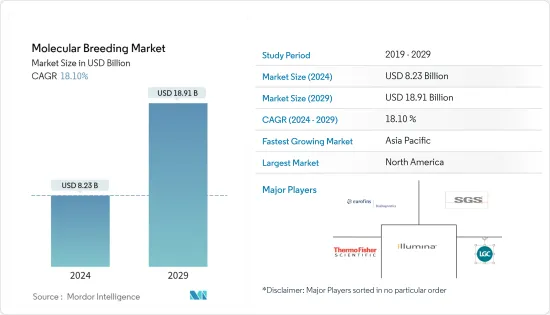 |
市場調查報告書
商品編碼
1433941
分子育種-市場佔有率分析、產業趨勢/統計、成長預測(2024-2029)Molecular Breeding - Market Share Analysis, Industry Trends & Statistics, Growth Forecasts (2024 - 2029) |
||||||
※ 本網頁內容可能與最新版本有所差異。詳細情況請與我們聯繫。
分子育種市場規模預計2024年為82.3億美元,預計到2029年將達到189.1億美元,在預測期內(2024-2029年)複合年成長率為18.10%成長。

開發作物新品種的過程幾乎需要20-25年,但利用生物技術,這個時間可以縮短到幾乎7-8年。標記輔助選擇 (MAS) 等工具使科學家能夠更輕鬆、更快速地選擇能夠產生更高產量結果的植物性狀。分子育種技術仍處於起步階段。在荷蘭和英國,分子育種技術100%用於農作物新作物。主要企業正在採用這些技術來改進其種子品種。遺傳學和研究領域的價格下降將改善市場。來自公共和私營部門的資金正流向植物育種和基因研究,包括基因組選擇和 MAS 在大田和蔬菜作物中的應用,這將刺激未來的市場。預計在預測期內,亞太地區的分子育種市場將成長最快。
分子育種市場趨勢
玉米產量大幅增加
全球對糧食生產和消費的需求正在迅速成長。美國玉米平均產量已從20世紀上半葉的1.6噸/公頃增加到約9.5噸/公頃。產量的顯著提高歸功於混合玉米的採用、合成肥料的使用以及推動分子育種市場的新農業方法。分子育種性狀的介紹和使用基於 DNA 標記的新育種技術的開發為分子育種創造了一個新的創新市場。例如,在未來 20 年裡,生物技術性狀和標記輔助育種可能會使美國的玉米產量增加一倍。
北美地區佔比最大
2017年,北美在分子育種市場中佔據最大佔有率,農民對分子育種益處的認知不斷增強,其次是歐洲,因為小麥和玉米產量較高,這將增加未來前景,市場預計將擴大。市場。美國和加拿大以及歐洲的領先公司的存在導致分子育種市場的採用率不斷提高。由於印度、中國和泰國等主要企業的投資增加,亞太地區分子育種市場預計將以最高的速度成長。
分子育種產業概況
分子育種市場高度分散,領導企業採取了產品定價分析、新產品開發、收購合併、擴張、合作等多種策略來在市場上留下自己的足跡。像先正達這樣的領先公司使用 Thermo Fisher Scientific 高度修改的基因型鑒定平台來提供其育種管道所需的資料,並識別具有更好產量潛力的新植物。快速選擇品種。
其他福利
- Excel 格式的市場預測 (ME) 表
- 3 個月分析師支持
目錄
第1章簡介
- 研究成果
- 研究場所
- 調查範圍
第2章調查方法
第3章執行摘要
第4章市場動態
- 市場概況
- 市場促進與市場約束因素介紹
- 市場促進因素
- 市場限制因素
- 產業吸引力-波特五力分析
- 新進入者的威脅
- 買家/消費者的議價能力
- 供應商的議價能力
- 替代品的威脅
- 競爭公司之間敵對關係的強度
第5章市場區隔
- 按用途
- 植物
- 家畜
- 按標記
- 簡單的數組迭代
- 單核苷酸多態性
- 表達序列標籤
- 其他
- 分子育種過程
- 標記輔助選擇
- QTL作圖
- 標記輔助回交
- 按地區
- 北美洲
- 美國
- 加拿大
- 墨西哥
- 其他北美地區
- 歐洲
- 德國
- 英國
- 法國
- 俄羅斯
- 西班牙
- 其他歐洲國家
- 亞太地區
- 中國
- 日本
- 印度
- 韓國
- 其他亞太地區
- 世界其他地區
- 北美洲
第6章 競爭形勢
- 最採用的策略
- 市場佔有率分析
- 公司簡介
- Illumina
- LGC Limited
- Thermo Fisher Scientific
- SGS
- LemnaTec
- Charles River
- DanBred
- Intertek
- Eurofins
第7章 市場機會及未來趨勢
The Molecular Breeding Market size is estimated at USD 8.23 billion in 2024, and is expected to reach USD 18.91 billion by 2029, growing at a CAGR of 18.10% during the forecast period (2024-2029).

The process of developing new crop varieties almost takes around 20- 25 years but this time limit can be shortened to almost 7-8 years by using biotechnology. Tools like marker-assisted selection (MAS) make it easier and faster for the scientist to select plant traits with more productive results. Molecular breeding technology is in the nascent stage. Netherland and UK witnessed 100% adoption of molecular breeding techniques for new crop variety. Major players in seed companies have been adopting these technologies for improvement in seed varieties. The decline of prices in the genetic and research departments leads to the improvement of the market. Funds flow from private as well as public sectors towards plant breeding and genetic research such as genomic selection in field and vegetable crops and application of MAS will gear up the market in the future. The molecular breeding market is projected to grow highest in the Asia-Pacific region during the forecast period.
Molecular Breeding Market Trends
Increase in production of Corn exponentially
Global demand for food production and consumption increasing at a rapid pace. U.S. average corn yield has increased from 1.6tonnes/hectare in the first half of the 20th century to approximately 9.5tonnes/ha. The dramatic yield improvement is due to the use of hybrid corn, synthetic fertilizers, and the adoption of new farm practices that drives the molecular breeding market. Introduction of molecular breeding traits and development of new breeding technology using DNA based markers created a new and innovative market for molecular breeding. For instance, Over the next two decades, biotechnology traits and marker-assisted breeding have the potential to double the corn yields in the U.S.
North America account for largest share
North America accounted for the largest share in the molecular breeding market in 2017, followed by Europe due to high yield in the production of wheat and maize as awareness among the farmers about the benefits of molecular breeding are increasing which will create a scope in the future market. The presence of major companies in US and Canada followed by Europe has resulted in increasing adoption of the molecular breeding market. The Molecular breeding market in the Asia-Pacific region is projected to grow with highest rate due to increasing investment from the key players in countries such as India, China, and Thailand.
Molecular Breeding Industry Overview
The molecular breeding market is highly fragmented and major players have used many strategies such as pricing analysis of the product, new product development, acquisition and mergers, expansion, the partnership to make a footprint in the market. Major players like Syngenta using advance modified genotyping platforms from "Thermo Fisher Scientific" to provide necessary data for the breeding pipeline to quickly select the new varieties with much better yield potential.
Additional Benefits:
- The market estimate (ME) sheet in Excel format
- 3 months of analyst support
TABLE OF CONTENTS
1 INTRODUCTION
- 1.1 Study Deliverables
- 1.2 Study Assumptions
- 1.3 Scope of the Study
2 RESEARCH METHODOLOGY
3 EXECUTIVE SUMMARY
4 MARKET DYNAMICS
- 4.1 Market Overview
- 4.2 Introduction to Market Drivers and Restraints
- 4.3 Market Drivers
- 4.4 Market Restraints
- 4.5 Industry Attractiveness - Porter's Five Force Analysis
- 4.5.1 Threat of New Entrants
- 4.5.2 Bargaining Power of Buyers/Consumers
- 4.5.3 Bargaining Power of Suppliers
- 4.5.4 Threat of Substitute Products
- 4.5.5 Intensity of Competitive Rivalry
5 MARKET SEGMENTATION
- 5.1 On basis of application
- 5.1.1 Plant
- 5.1.2 Livestock
- 5.2 On basis of marker
- 5.2.1 Simple sequence repeat
- 5.2.2 Single nucleotide polymorphism
- 5.2.3 Expressed sequence tags
- 5.2.4 Others
- 5.3 On basis of molecular breeding process
- 5.3.1 Marker assisted selection
- 5.3.2 QTL Mapping
- 5.3.3 Marker assisted back crossing
- 5.4 Geography
- 5.4.1 North America
- 5.4.1.1 United States
- 5.4.1.2 Canada
- 5.4.1.3 Mexico
- 5.4.1.4 Rest of North America
- 5.4.2 Europe
- 5.4.2.1 Germany
- 5.4.2.2 United kingdom
- 5.4.2.3 France
- 5.4.2.4 Russia
- 5.4.2.5 Spain
- 5.4.2.6 Rest of Europe
- 5.4.3 Asia Pacific
- 5.4.3.1 China
- 5.4.3.2 Japan
- 5.4.3.3 India
- 5.4.3.4 South Korea
- 5.4.3.5 Rest of Asia-Pacific
- 5.4.4 Rest of World
- 5.4.1 North America
6 COMPETITIVE LANDSCAPE
- 6.1 Most Adopted Strategies
- 6.2 Market Share Analysis
- 6.3 Company Profiles
- 6.3.1 Illumina
- 6.3.2 LGC Limited
- 6.3.3 Thermo Fisher Scientific
- 6.3.4 SGS
- 6.3.5 LemnaTec
- 6.3.6 Charles River
- 6.3.7 DanBred
- 6.3.8 Intertek
- 6.3.9 Eurofins








